Famous Civil War submarine: H. L. Hunley
A recent article in Popular Science has showcased fascinating research into the circumstances of the Confederate submarine H L Hunley’s crews’ deaths.
During the American Civil War the Navy of the Confederate States were heavily outgunned by the Union’s navy. Invariably the development of sneak attack craft is born of desperation as an effort to confront the numerically and qualitatively superior force. The Union were imposing an effective naval blockade on the Confederate States and this naval discrepancy worked in the submarine’s favor. Almost from the outset of the war it was apparent that the South would be unable to meet the Union’s fleet on equal grounds, and development of asymmetrical means was encouraged which resulted in a brief periods of rapid development of underwater sneak submarines. Civilian engineers were invited to submit proposals to the Confederate Navy and promised financial rewards for successful designs.
Best known of these Confederate sneak craft was the HL Hunley. She was the last of three submarines built by a team of engineers led by Mr James McClintock, and including an engineer named Horace L Hunley.
Original artwork. CLICK for high-resolution image.

Pinoeer
The first craft was called Pioneer and had to be scuttled to preserve its secrecy when the Unionist forces closed in on New Orleans. Pioneer was a similar shape to the David but fully enclosed with a steel hull and circular hatch protruding from the top.
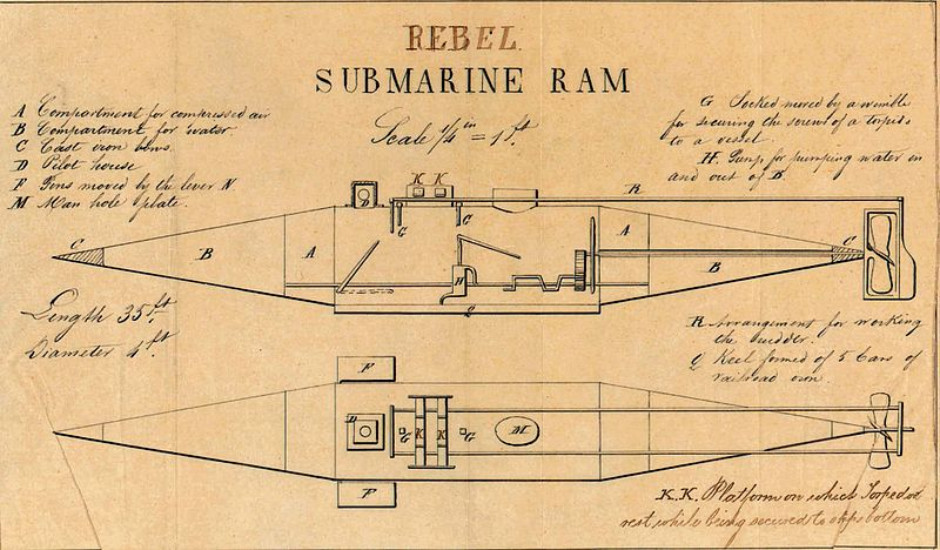
Contemporary illustration of the Pioneer
The ultimate book of Special Forces subs Covert Shores 2nd Edition is the ONLY world history of naval Special Forces, their missions and their specialist vehicles. SEALs, SBS, COMSUBIN, Sh-13, Spetsnaz, Kampfschwimmers, Commando Hubert, 4RR and many more.
Check it out on Amazon
American Diver
Following the Pioneer’s sinking, a second craft was built in Mobile, Alabama where the design team had fled to escape the advancing enemy. This was named American Diver, and featured a generally cylindrical hull cross-section but with a narrow bow and stern that made it a bit boat shaped at either end. Impressively, this shape was relatively hydrodynamic and allowed it to cut the water when running on the surface. The American Diver was promising but tragically sank while being towed during a test. The reason for the loss was unexplained at the time but it seems likely that it simply flooded through open hatches and sank.
Porpoise, later renamed H. L. Hunley
The engineers were undeterred and a third submarine was soon built from leftover boiler plate at a factory in Mobile. The new craft, which was essentially a lengthened American Diver, was named Porpoise. Similarly to the other submarines, no engine could be used underwater so propulsion was provided by six or seven men hand-cranking the propeller shaft that ran down the center of the submarine from a large shrouded propeller at the stern. The propeller shaft was attached by brackets from the port (left) side of the hull, with the men leaning against the starboard (right) hull. The forward position also operated the hydroplanes, again by hand. Testing was not always safe with her sinking twice during trials. It was during one of these incidents that the co-inventor Mr. Hunley perished along with the entire crew. In his honor the submarine was renamed the H.L. Hunley.
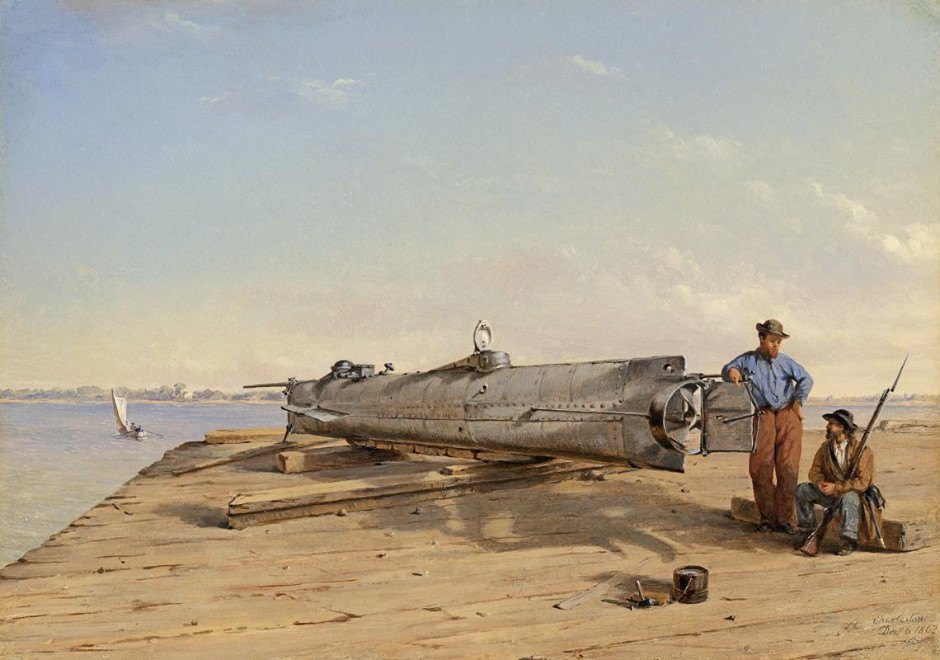
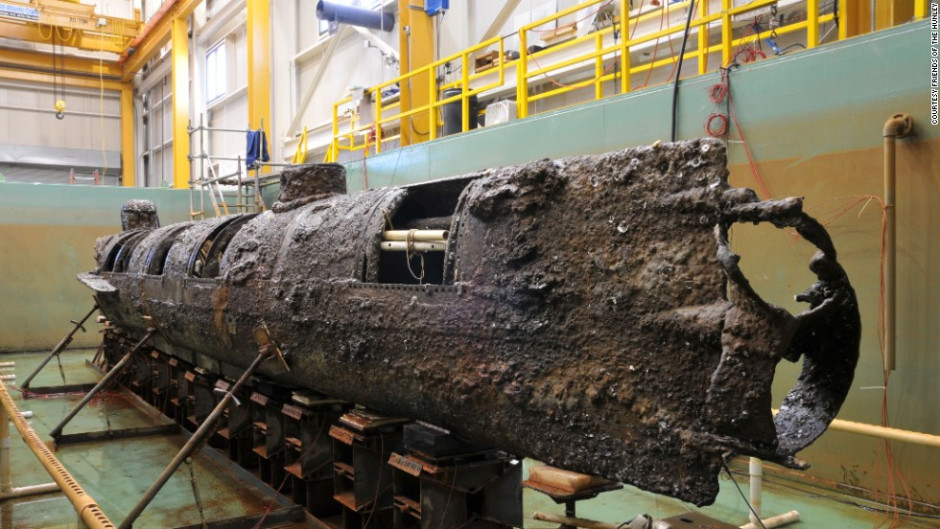
A painting of the H. L. Hunley by Conrad Wise Chapman (1863) and the wreck of the submarine from the same angle.
Despite these setbacks the craft’s design was impressive for the time and indeed a precursor to modern midget submarines. Initially the armament was to be a floating charge that was towed behind the submarine. The concept was that the submarine would approach on the surface at night, and then submerge as it approached the target to avoid visual detection and make hitting it with gunfire much harder if it was detected. The submarine would pass under the hull of the target while the charge, floating on the surface many feet behind, would snag on it and explode. This device could have been effective, and was demonstrated on an old barge with impressive effect, but in practice controlling the location of the charge from the submarine was too hard and there was no guarantee that the charge would hit the target. It’s likely that the crew would not know whether the charge was floating to port or starboard of their track and so could not aim it at the target. Therefore the weapon was changed to a barbed spar torpedo mounted at the base of the bow. This was to be triggered by means of pulling a rope, although archaeological evidence may suggest it was in fact electrically detonated.
Attack
On the night of 17th February 1864 the Hunley snuck into Charleston Harbor and approached a Union warship, the USS Housatonic, which was about five miles off the coast. Housatonic was considered a ‘sloop of war’, but at over 1400 tons with 150 men, eight cannons and steam power she was quite powerful and an integral part of the Union blockade. Accounts suggest the submerged submarine was spotted, but too late and successfully embedded her torpedo into the ship’s hull before effective fire could be brought to bear. It’s also likely that the ship’s cannons could not have been depressed enough to fire at the submarine anyway. With the charge in place, it was released from the submarine which back-peddled in an attempt to get clear of the imminent explosion.
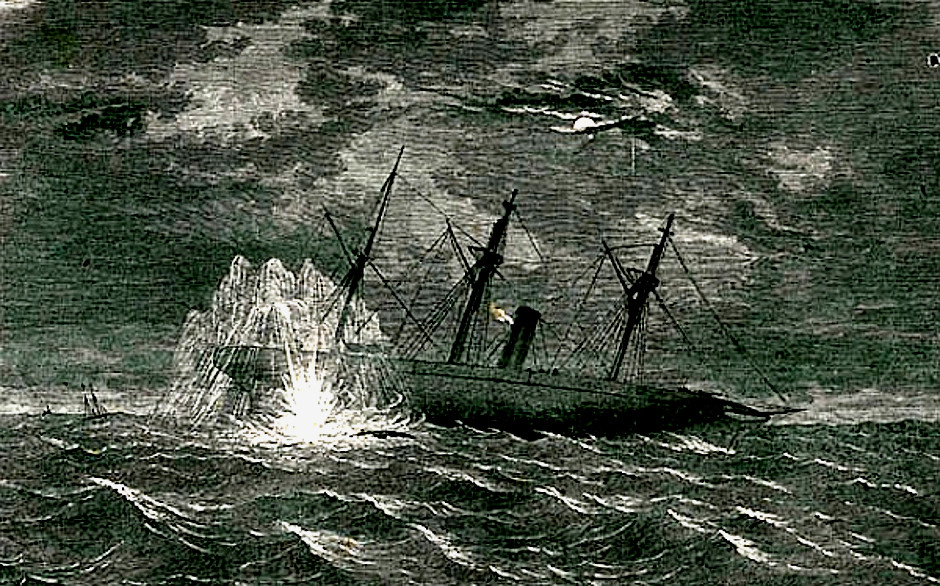
Contemporary drawing of the attack.
However the explosion was triggered, whether intentionally from the submarine or by accident, the results were catastrophic for the submarine as well as the warship, both sank. Accounts vary, with myth and legend building up a romanticized picture of the attack, with heroic last signals to the port from the submarine and so on. The reality, indicated by archeological evidence, is more down to earth but no less heroic. Only five of the Housatonic’s crew perished but all eight men on board the Hunley were lost. Similarly if you were to add up those lost in other attacks and accidents the death toll among the Confederate torpedo boats and submarines was much higher than those inflicted on the enemy. But the impact on history was far greater; a new age of underwater warfare had begun.
Wreck
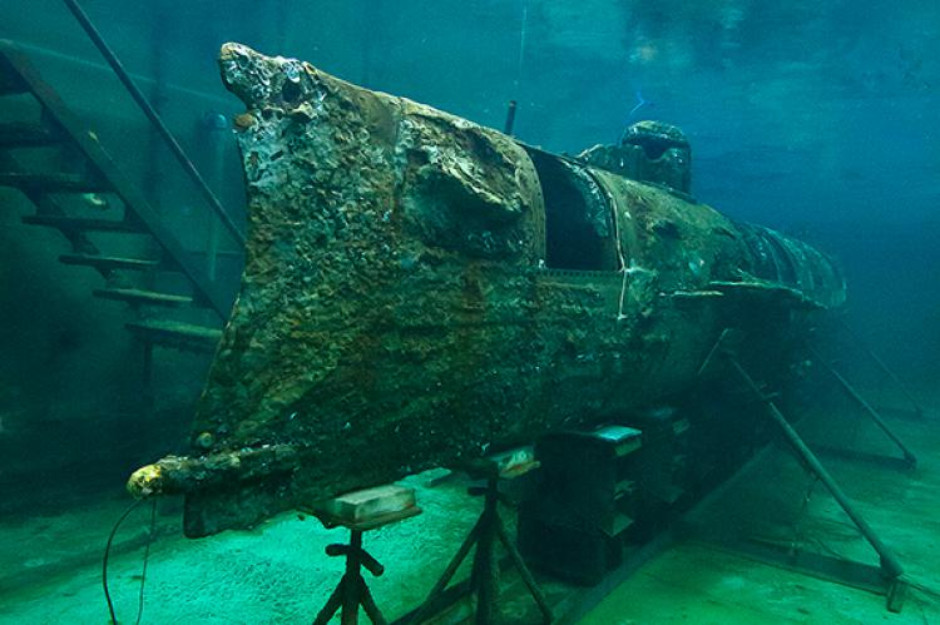
The wreck of the Hunley was located in 1995 by author Clive Cussler and raised on August 8th 2000. It entered a period of careful conservation at the Warren Lasch Conservation Center, where an international team of scientists are at work to conserve the submarine for future generations and piece together clues to solve the mystery of her disappearance. Visit hunley.org
Recent research by Rachel Lance points to the force of the underwater blast as the cause of the death of the crew, who died in their seats. When explosions occur underwater deadly shockwaves radiate from them which can cause a human’s internal organs to rupture. This is the most likely fate of the crew. See this article in Popular Science.
Related articles (Full index of popular Covert Shores articles)
 SDV Mk.9 SEAL Delivery Vehicle
SDV Mk.9 SEAL Delivery Vehicle
 CCH (Combat Craft Heavy) SEALION and Alligator Semi-Submersible Boats
CCH (Combat Craft Heavy) SEALION and Alligator Semi-Submersible Boats
 Japanese Ko-Hyoteki midget submarine of WW2 - Pearl Harbor attack
Japanese Ko-Hyoteki midget submarine of WW2 - Pearl Harbor attack
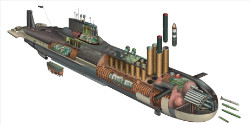 Russian Typhoon Class SSBN
Russian Typhoon Class SSBN
 Armored Stealth Boat used for car smuggling by Chinese organized crime
Armored Stealth Boat used for car smuggling by Chinese organized crime
 Cutaway of Jules Verne’s Nautilus
Cutaway of Jules Verne’s Nautilus
 Narco Subs 101
Narco Subs 101
 LTTE Sea Tigers' sneak craft and midget subs
LTTE Sea Tigers' sneak craft and midget subs

